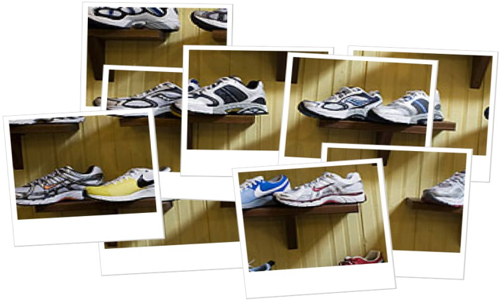Top 10 running shoe myths

It's the battle without end: popular running shoe dogma against reason, experience and common sense. Guess which side I'm on. I call it the "dumb running shoe myth" syndrome. It's a collection of widely held beliefs that are at best half-truths or, more often, just totally bogus notions. They emerge from a variety of sources, including your running friends with caffeine-powered imaginations, young clerks in sports stores that stock more shoes for basketball than running, and of course, that bastion of running footwear misinformation, other magazines. Not running magazines, mind you, but rather that tacky newsstand pulp with model-laden covers that boldly promise to help you look better, feel better and, of course, have a better sex life. Naturally you snap them up because you look like a train wreck, feel like a pile of garbage and haven't had a decent sexual encounter since, uh, ever. But last month's authoritative report on the five best cigars on earth or this month's rundown of the top-six sport utility vehicles didn't turn your life around, so you can bet that next month's review of the 10 best running shoes in the universe won't deliver either.
Which brings us to item number 1 in Shoe Guy's top-10 list of all-tune dumb running shoe myths: There is a best running shoe. Maybe for you there is, and maybe for your best friend, there is, but it's unlikely they're the same model. There is no one running model on earth (or even in your local running-specialty store) that's best for everyone. Because we all have unique bio-mechanical and training needs, what's best for each individual is very much an individual thing.
Myth number 2: Finding the right running shoe is the key to happiness. More cheesy magazine crapola. It's running that is the key to happiness for most of us. The shoes are merely tools that are just along for the ride. Okay, they often help make that ride possible, but you still have to do the work.
Myth number 3: If your running shoes show wear on the outside of the heel, you are a supinator. Nope. Wear on the outside of the heel means you are a very ordinary heel striker. Most runners land on their heels, and the lateral side strikes first because that's what feet normally do. Whether you are a supinator, pronator or some other kind of -ator is determined by the motion the foot experiences after it lands.
Myth number 4: Size matters. Don't worry - only one sex joke per column. Shoe size (the number printed on the shoe box) doesn't matter. What matters is fit. Regardless of what shoe size you think you wear, the best running shoe for you is one that fits your feet correctly: snug heel, secure lacing system, comfortable space for the ball of the foot, and adequate wiggle room for the toes. Shoe sizes may vary, but fit should be consistent.
Myth number 5: Cushioning technology matters. Sure, it matters that your shoes absorb shock well, but how they do it matters not. All those cushioning technologies seem to work pretty well. If you want to figure out which works best, you'd better build a very big laboratory.
Myth number 6: Women's running shoes are just narrower, prettier and less adequate versions of men's. Once upon a time this was true, but not lately. Women's shoes are increasingly different front men's, but only in ways that make them better for most women. Different lasts, different upper materials and different support properties mean women's shoes are better and more gender-specific than ever. No, the industry didn't develop a conscience; it's just the good old profit motive at work. Women have bought more athletic shoes than men now for the last two years in a row.
Myth number 7: Good running shoes have good arch support. It's full-foot support that matters here, not that nebulous, old-fashioned notion called "arch support." Like the rest of the foot, the arch needs to be allowed to function properly in helping the foot adapt to the ground. Good running shoes complement the foot's efficiencies and compensate for its weaknesses, a broader concept than just supporting the arch.
Myth number 8: Good shoes don't need to be broken in, so if new shoes feel good in the store, they will feel just as good after that 18-miler you plan for the next day. Sure, you know better. Or maybe you don't. It's not the shoes that need breaking in so much as you. Your body needs a few gentle miles to adapt to the fresh support of new shoes, so take it easy for the first couple of runs. Either that, or stock up on ice, ibuprofen and your favorite blister treatment.
Myth number 9: When a shoe company replaces an old shoe with a new model, it's always for a good reason. A new shoe may be superior to an oldie, but usually the reason for the update is the calendar rather than the need for real improvement. In most cases, before you've even seen your next "favorite" shoe, its replacement is already on the drawing board.
And finally, myth number 10: Shoe-lace installers at running shoe factories can tell she difference between 36 inches and 136 inches. It's not just running shoe myths that are dumb.
Credits - WorldwideRunning.com would like to thank J.D. Denton for the permission to reprint his article "10 Dumb Running Shoe Myths and how to dispel them", originally published in the October 1999 issue of "Running Times". J.D. Denton owns and manages a Fleet Feet store in Davis (Usa/California). Under the pen name of "Shoe Guy", he is a widely recognized writer and expert on running shoes.

